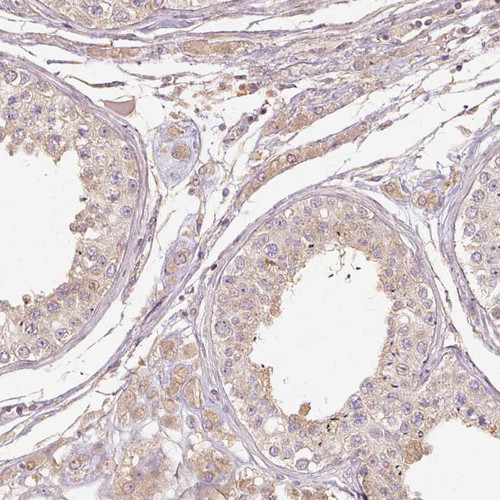Anti RB1CC1 pAb (ATL-HPA053049)
Atlas Antibodies
- SKU:
- ATL-HPA053049-25
- Shipping:
- Calculated at Checkout
$303.00
Gene Name: RB1CC1
Alternative Gene Name: ATG17, Cc1, DRAGOU14, FIP200, KIAA0203, PPP1R131
Isotype: IgG
Interspecies mouse/rat: ENSMUSG00000025907: 95%, ENSRNOG00000006833: 93%
Entrez Gene ID: 9821
Uniprot ID: Q8TDY2
Buffer: 40% glycerol and PBS (pH 7.2). 0.02% sodium azide is added as preservative.
Storage Temperature: Store at +4°C for short term storage. Long time storage is recommended at -20°C.
| Product Specifications | |
| Application | ICC, IHC |
| Reactivity | Human |
| Clonality | Polyclonal |
| Host | Rabbit |
| Immunogen | QGWAAIMANLEDCSNSYQKLLFKFESIYSNYLQSIEDIKLKLTHLGTAVSVMAKIPLLECLTRHSYRECLGRLDSLPEHEDSEKAETKRSTELVLSP |
| Gene Sequence | QGWAAIMANLEDCSNSYQKLLFKFESIYSNYLQSIEDIKLKLTHLGTAVSVMAKIPLLECLTRHSYRECLGRLDSLPEHEDSEKAETKRSTELVLSP |
| Gene ID - Mouse | ENSMUSG00000025907 |
| Gene ID - Rat | ENSRNOG00000006833 |
| Buffer | 40% glycerol and PBS (pH 7.2). 0.02% sodium azide is added as preservative. |
| Documents & Links for Anti RB1CC1 pAb (ATL-HPA053049) | |
| Datasheet | Anti RB1CC1 pAb (ATL-HPA053049) Datasheet (External Link) |
| Vendor Page | Anti RB1CC1 pAb (ATL-HPA053049) at Atlas Antibodies |
| Documents & Links for Anti RB1CC1 pAb (ATL-HPA053049) | |
| Datasheet | Anti RB1CC1 pAb (ATL-HPA053049) Datasheet (External Link) |
| Vendor Page | Anti RB1CC1 pAb (ATL-HPA053049) |
| Citations for Anti RB1CC1 pAb (ATL-HPA053049) – 1 Found |
| Turco, Eleonora; Witt, Marie; Abert, Christine; Bock-Bierbaum, Tobias; Su, Ming-Yuan; Trapannone, Riccardo; Sztacho, Martin; Danieli, Alberto; Shi, Xiaoshan; Zaffagnini, Gabriele; Gamper, Annamaria; Schuschnig, Martina; Fracchiolla, Dorotea; Bernklau, Daniel; Romanov, Julia; Hartl, Markus; Hurley, James H; Daumke, Oliver; Martens, Sascha. FIP200 Claw Domain Binding to p62 Promotes Autophagosome Formation at Ubiquitin Condensates. Molecular Cell. 2019;74(2):330-346.e11. PubMed |


